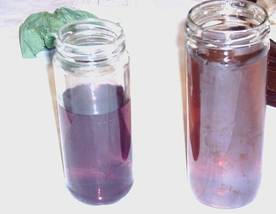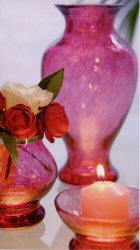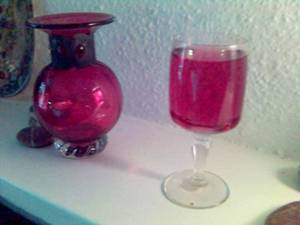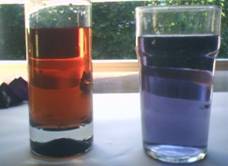
|
|
Purple Gold Nick Kollerstrom To make your own purple gold, prepare a dilute solution of gold chloride, say 0.01%, and a solution of Rochelle salt[1] (a weak reducing agent), say 1%. Add the one to the other, and there, before your amazed gaze, the solution will slowly grow into pure purple.[2] Or, maybe it won’t. It seems quite temperamental. I tried to repeat the experiment using tap water instead of distilled and a dirty blackish hue appeared. But, the next day this had turned ruby-red (see below). Rochelle salt is essentially prepared from tartar that settles out from wine as it ferments[3], so maybe this is part of the mystical meaning of the colour: a wine-compound, on the very border between organic and inorganic, living and dead, is needed to make the marvellous purple gold.[4] A colleague had heard that adding a few drops of some essential oil to the solution would help to keep it in suspension. A week later he came back, and the original purple solution had turned blue.[5] Figure: ‘purple gold’ solution that I made on 23.5.05, using Rochelle salt, and on the right my attempt at purple of Cassius.’ What used to be called 'Purple of Cassius' is made by adding some tin to a ‘very dilute’ gold solution. Just what the tin does to produce this purple hue remains a mystery. I made up a solution of stannous chloride, which grows cloudy (I guess the hydroxide is formed), and then adding this to the gold solution a rich hue of golden-amber appeared. This is quite impressive – but isn’t Purple of Cassius![6] This pleasant amber hue will last for a week or so, then it settles out. One can also reduce the gold by using formaldehyde. On this method, the gold solution needs to be made alkaline: I here added some bicarbonate of soda. Adding a drop of formaldehyde, nothing happens for quite a while. After several minutes, the solution grows purple. This is a rather muddy hue and far from being so attractive as that produced by the Rochelle salt. But, it is of interest to see a reaction that takes some minutes to react. If you can get some tri-sodium citrate then: add a few ml of gold chloride to boiling water, then add some 1% tri-sodium citrate and ‘boil until the colour develops’ (I haven’t tried this). Sunlight will tend to precipitate the colloid, so the solution is best kept in shady spot. I could hardly find anything written on this subject since Michael Faraday’s essay[7]. Experiential chemistry has vanished from our civilisation and I suggest we need to bring it back again. Gold is the precious Sun-metal: that is to say, it expresses and tells us about solar glory[8]. Its being is very much radiant, and that is a matter which concerns high dilutions. Gold does not occur in seams or veins like other metals, rather it occurs spread out through Earth’s crust in a high dilution. RUBY GLASS  Beautiful glasses of pink and ruby red are made using gold, at about 10-15 parts per million[9]. Every alchemist should have one: ‘There are other chemicals which produce red glass, but none which have the special magic of gold ruby.’[10] Hear, hear! They aren’t expensive. While you’re at it, why not also ask for a deep-blue cobalt-hued beaker?[11] Talking with glaziers, they seemed perplexed by the way I was mainly interested in the metal used in the pigments. It in indeed a thrill to be invited into the laboratory, and behold the fiercely-glowing furnace. But, one feels is a sense of tragedy, because modern glaziers do not know what metal is producing a given hue. The companies won’t reveal this, and indeed a large number of compounds may be involved. Thus, you can try asking for a glass whose hue derives from a copper pigment (turquoise, maybe?), but I doubt whether you will get very far!  The picture shows a lovely vase of ruby gold, and next to it a colloidal solution of gold having an identical hue. I made this using the tartar solution as described above, but it may have been too concentrated because the whole solution went black. Then the next day it had developed into this ruby hue. It is quite stable, and the photo was taken a month after it was made. A Replication  I tried the experiments again in mid-July. Nothing happened with the Rochelle salt solution, but the stannous chloride with gold gave a rather reddish amber hue, here shown, which precipitated in a few days, as the red colour deepened. Using the formaldehyde method gave a dusky purple, also shown. The mixture did nothing for five minutes, then rather suddenly turned a deep purple. That does impress people. COLLOIDAL GOLD In the 1930s, before anyone had colour photography, Lily Kolisko published chromatogram-images made by having a 1% solution of gold chloride rising up the filterpaper and drying, in sunlight; then she let another lot of solution rise up through it, in a larger quantity. Some purplish hues were visible, on one was made in the early morning of 19.6.36, a couple of hours after a solar eclipse.[12] I obtained golden-type hues by this method, but nothing exotic like hers.[13] Gold can be used in photography, as it is precipitated by sunlight. Sir John Herschel pioneered this process back in 1832, and then it was rather sidelined by use of silver. A modern chemist has reconstructed and improved this gold-chloride based photography method. After thousands of experiments over years, he found out how ‘to 'tame' the ‘vigorous and unpredictable behaviour of the gold salts’ (I was relieved to hear this). Just from one gold salt, a startling variety of colours would appear: ‘The colours so obtained, including pink, magenta, brown, purple, violet, blue and green, are not of course 'true to life' -they might even be described as surreal- because this is still essentially a monochrome printing process … It may therefore seem incomprehensible that a single, pure substance -gold, in a finely divided state- can appear with so many different colours.’[14] As the Sun-metal, gold manifests these different colours of the daytime: it is of the essence of gold, that it wants to do this. Let’s try to picture it alchemically in these terms, rather than just chemically in terms of the different sizes of the colloid-particles.[15] GOLD-COLOURED GLASS There is a German company that is able to make different hues of glass from gold: all colours except green, I was informed. No English glazier can make any glass hue other than ruby, using gold – and those who can do that are few enough. Clearly, glasses of different hues made from gold would be of especial value for therapeutic work: ‘healing light’. However, this German company would not let me have any pictures of the glass they make: their book will be coming out at the end of 2006 and one has to wait until then! CHARTRES CATHEDRAL  The glorious blues and reds of the stained-glass windows at Chartres were made from copper. A glazier friend who had published on Medieval glassmaking spent a few days around Chartres and then informed me of this. There was no possibility of it being gold, he explained, because ruby-gold glass was not invented until the 17th century. He admired the blue glass formed but was especially in awe of the red hues, made from copper. I had spent about twenty years wondering about this: Louis Charpentier, in his The Mysteries of Chartres Cathedral (1966) did not know. By way of trying to stimulate an interest in practical chemistry, here is the frontispiece of a 17th-century German textbook[16], when chemistry was just emerging from alchemy. It was published just after the recipe for making ruby-gold glass was found. [1] Chemically, it is potassium sodium tartrate. It exhibits double refraction and is used in silvering mirrors. Crystals of Rochelle salt are easily grown and are used in piezoelectric devices, e.g., crystal microphones. [2] These recipes appeared in The Hermetic Journal, Issue 41, p.20 (anon.), kindly supplied by Adam McLean. [3] Broadly speaking, one adds sodium carbonate to Cream of Tartar until it stops fizzing. Then, allow the solution to crystallise [5] Mr Guy Ogilvie, alchemist, prepared the Rochelle salt. I never saw the blue hue, which, he claimed, remained for a couple of weeks. [6] The recipe said that it might be helpful to add traces of stannic chloride, which I tried. It added that the colour would vary depending on the acid-alkali balance – but, I didn’t find this. [7] Michael Faraday Experimental Relations of gold and other metals to Light 1857 Philosophical Transactions, 147, Part I, pp. 145-181. [9] One glazier explained to me: ‘I use Sodium Tetrachloroaurate, a very acidic heavy yellow liquid which is 40% gold by weight. I last worked with it when I was doing a research contract for Waterford Crystal about 10 years ago. I got the most beautiful rose pinks at about 16ppm gold in the glass, but it was not going to be possible for them to reproduce it on an industrial scale. The trouble with gold is it is very dense and sinks to the bottom quite quickly, which makes colour control extremely difficult. (P.H.)’ [11] Order from glazier Anthony Stern: www.anthonysternglass.com [12] L.Kolisko, ‘Gold and the Sun – the Total Eclipse of 19.6.36,’ 1936. [15] M.Aslam et. al., ‘…Aqueous Colloidal Gold Nanoparticles,’ J. Mater. Chem. 2004,pp.1795-97. 8 |